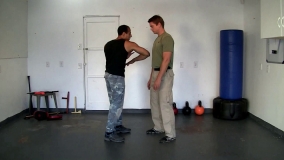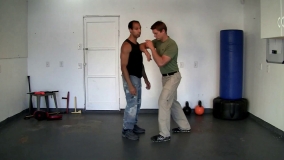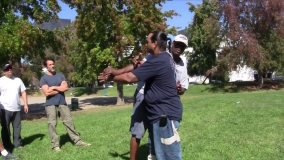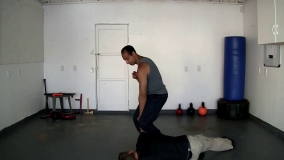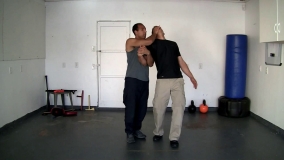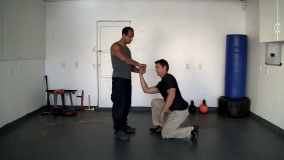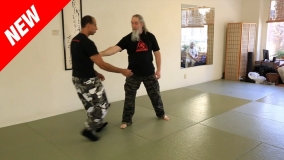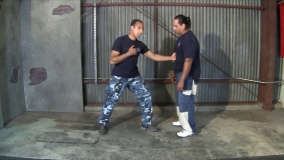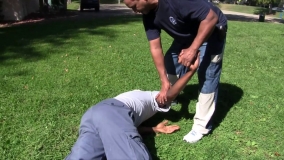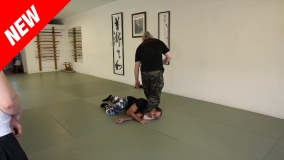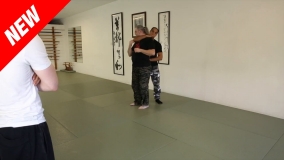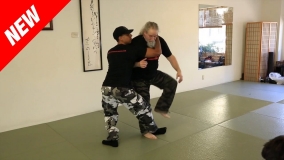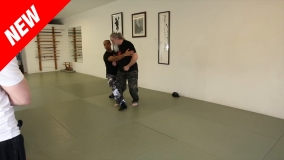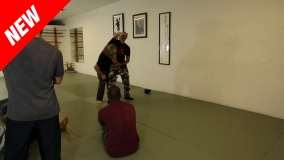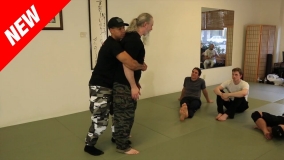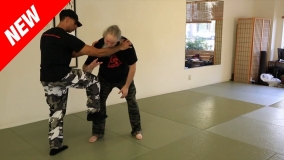Self-Defense

III. Create/Cause Trauma
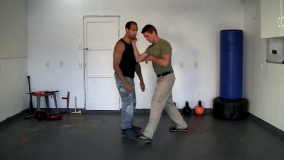 Dave Critiques Jon As Jon Practices Getting Power Behind His 9 Angle Fist Strikes
Dave Critiques Jon As Jon Practices Getting Power Behind His 9 Angle Fist Strikes2 minutes and 48 seconds
Dave critiques Jon as Jon learns to generate increasing power behind his 9 strike pattern with his fists. This is an important drill for learning proper bone alignment. This will not only help you to hit harder, but is also important for finding strong bone alignment so you don’t injure yourself when applying your strikes.
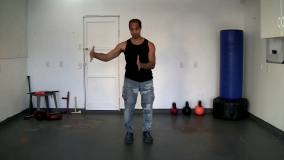 Wrist Flexion Strikes Breakdown And Drills On The 9 Angles
Wrist Flexion Strikes Breakdown And Drills On The 9 Angles6 minutes and 15 seconds
Dave shows how to strike with your wrists on all 9 angles of attack. Practice these drills at home to develop devastating power with your wrist flexion strikes. These are important strikes for all ranges and especially at super close range.
 Wrist Flexion Strikes Demonstration, Applications, And Drills
Wrist Flexion Strikes Demonstration, Applications, And Drills4 minutes and 50 seconds
Dave demonstrates the applications of wrist flexion strikes. He also shows a simple exercise that can be practiced at home to learn how to develop coordination for fast combination hitting with the wrist flexions.
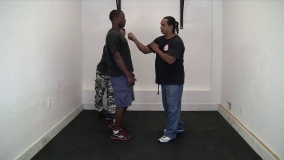 Striking Flowing Drill That Begins With Knives And Ends With Empty Hands
Striking Flowing Drill That Begins With Knives And Ends With Empty Hands21 minutes and 37 seconds
Dave and Indio teach Phil a great exercise to learn how to flow with your strikes. It begins by learning to slash and simultaneously strike with a knife. Then we learn to keep that same flowing motion, but with empty hands. The weapons will teach us how to flow and have graceful and efficient strike flow patterns even when we don’t have a weapon.
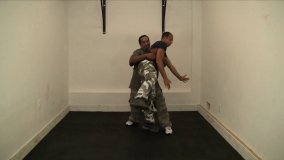 Sensitivity And Creativity Drill Combining Evading With Creating
Sensitivity And Creativity Drill Combining Evading With Creating6 minutes and 42 seconds
Dave and Indio explain a great partner drill that will teach you how to develop your sensitivity for evading pushes and grabs. The drill will also teach you how to create and cause trauma while you simultaneously evade. This is a very important drill to practice over and over again at home.
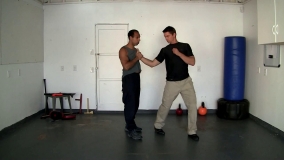 Shoulder Lock Breakdown
Shoulder Lock Breakdown7 minutes and 24 seconds
Dave breaks down the science of how to make the shoulder lock work along with how to effortlessly create infinite variations of shoulder locks. This is an important module that you might want to watch a few times and also revisit later as your understanding progresses.
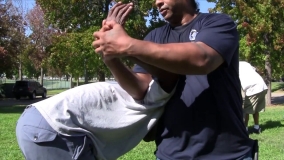 Indio Demonstrates How To Create Infinite Variations Of Shoulder And Elbow Locks With His Body
Indio Demonstrates How To Create Infinite Variations Of Shoulder And Elbow Locks With His Body2 minutes and 3 seconds
Indio explains how he can use his entire body as a fulcrum for leverage when executing shoulder locks and elbow locks. He helps students see that you do not need to memorize set techniques for shoulder and elbow locks. You can easily learn how to create infinite variations of these locks by learning the principle of two points of opposing pressure. Once that is understood you can learn how to incorporate your whole body to create multiple variations of shoulder and elbow locks.
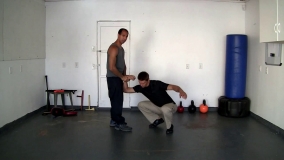 “Outer” Wrist Lock Breakdown
“Outer” Wrist Lock Breakdown7 minutes and 23 seconds
Dave explains the science behind the “outer” wrist lock. This video should give you a solid background so you can begin experimenting how to create your own technique variations of this powerful classic lock. This particular wrist lock is often seen in Aikido and in various martial art demonstrations.
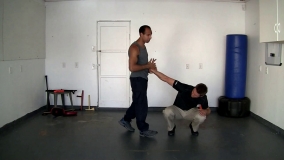 Wrist Lock Variation Breakdown
Wrist Lock Variation Breakdown6 minutes and 46 seconds
Dave leads us deeper into various wrist locks. This particular wrist lock is the opposite movement to the “outer” wrist lock. This type of wrist lock is common as well in various martial art demonstrations and is frequently seen in movies. It’s an effective lock and is easy to apply.Dave also reveals a simple yet powerful trick for adding pain for pain compliance when performing wrist locks.
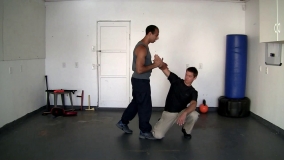 “Z” Wrist Lock Explanation and Breakdown
“Z” Wrist Lock Explanation and Breakdown7 minutes and 14 seconds
Dave explains how the science behind the “Z” wrist lock. He also shows how various dynamics can be added to the lock to increase pain for compliance. This is especially important for law enforcement, bouncers, or for anyone who wants to control someone without having to hurt them.
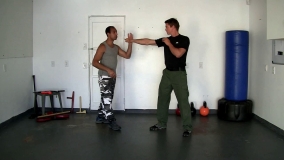 How To Apply Joint Locks While Standing
How To Apply Joint Locks While Standing17 minutes and 42 seconds
Dave teaches us how to use redirection and relaxation to set up wrist, elbow and shoulder locks all while in the standing position. This is a critical skill to develop. Many martial artists do not seem to understand how to apply joint locks from a standing position. The ideas presented in this module will help to demystify this often misunderstood area of the martial arts.
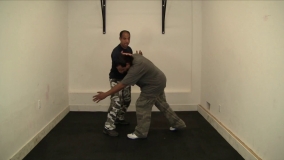 Demonstration Of Quick Draw Application With Spiraling Hands
Demonstration Of Quick Draw Application With Spiraling Hands6 minutes and 3 seconds
Dave and Indio demonstrate the applications of the quick draw home drill and the importance of utilizing spiraling hands. This drill and application will enable you to shut down an opponent very quickly by taking away your opponent’s eyes, center line, spinal integrity, and your opponent’s ability to utilize size, speed, and skill against you.
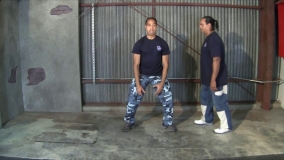 Utilizing Your 1 And 2 Foot Movements To Strike With Your Body
Utilizing Your 1 And 2 Foot Movements To Strike With Your Body4 minutes and 53 seconds
Dave and Indio explain how your foot movements are not only used to evade defensively, but also to generate tremendous power that can enable you to offensively attack your opponent with body strikes from your shoulders or ribs, for instance. They break down partner drills that you can practice at home utilizing foot movements 1 and 2.
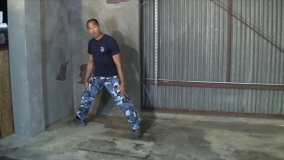 Intro For Developing Powerful Projection Strikes Through Proper Bone Alignment Of Your Lower Body
Intro For Developing Powerful Projection Strikes Through Proper Bone Alignment Of Your Lower Body6 minutes and 4 seconds
Dave introduces the concept of proper bone alignment of your lower body to maximize power with your strikes. Please watch this video first before watching the next video on aligning your upper body. This is a very important module.
 Dynamics For Developing Powerful Projection Strikes Through Proper Bone Alignment Of Your Upper Body
Dynamics For Developing Powerful Projection Strikes Through Proper Bone Alignment Of Your Upper Body8 minutes and 28 seconds
Dave teaches how to maximize your “bone power” or leverage via strong bone alignment with your upper body. This will be utilized with your strikes. He also reveals an interesting drill you can practice at home by yourself to test your alignment and also build up your strength. This video was filmed at a set in an industrial park and got a little noisy at times, but the audio is still clear. The content was good so we decided to still share this video on the site. Hope you enjoy the substantive content.
 Dave Explains Bio-Mechanics And Timing For Learning How To Hit Forward And Sideways
Dave Explains Bio-Mechanics And Timing For Learning How To Hit Forward And Sideways10 minutes and 36 seconds
Dave explains and demonstrates various drills for learning how to execute better timing for powerful hits while moving sideways and while moving forward. There are some great solo and partner drills in this module that you can practice at home to perfect your ability to hit with effortless power.
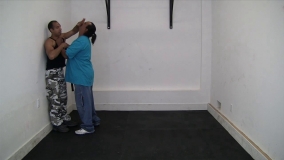 Dave Demonstrates How To Begin Hitting With Wrist Flexion Strikes
Dave Demonstrates How To Begin Hitting With Wrist Flexion Strikes5 minutes and 9 seconds
Dave demonstrates how to begin hitting with your wrists. He also gives an overview on hitting from various ranges. This wrist flexion exercise on the 9 angles of attack is a great drill that you can practice at home by yourself to learn how to develop flexibility, power, and coordination with your wrists. You can later incorporate your foot movements so you are hitting with your wrists while you’re simultaneously moving your feet.
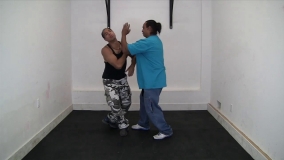 Dave and Indio Demonstrate Striking Drills And Applications With Wrist Flexion And Elbow Strikes
Dave and Indio Demonstrate Striking Drills And Applications With Wrist Flexion And Elbow Strikes12 minutes and 41 seconds
Dave and Indio demonstrates various home drills for learning how to strike with wrist flexion strikes and how to generate tremendous power with these subtle yet powerful hits. These are great self-defense weapons for long, medium, and close range encounters. Strikes with the wrists often flow into strikes with the elbows and other parts of the body.
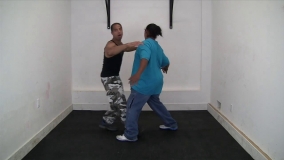 Dave And Indio Demonstrate How To Strike With Your Chest, Back, And Ribs For Close Ranges
Dave And Indio Demonstrate How To Strike With Your Chest, Back, And Ribs For Close Ranges6 minutes and 9 seconds
Dave and Indio demonstrate some home drills to practice for learning how to hit with your ribs, chest, and back. It’s important that you learn how to strike with every part of your body. Oftentimes with multiple attackers your hands will get tied up and you will need to be able to hit with other parts of your body such as the above. These are great self-defense strikes for close ranges.
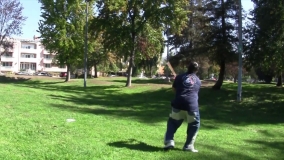 Indio Demonstrates How To Integrate Weapons Strikes While Executing Various Foot Movements
Indio Demonstrates How To Integrate Weapons Strikes While Executing Various Foot Movements1 minutes and 51 seconds
Indio demonstrates the importance of integrating weapons and incorporating various weapons strikes in combination with the foot movements. In doing so you will learn about momentum, timing, rhythm, and economy of motion. By playing around with these types of drills at home you will greatly enhance your ability to invent techniques as well along with gaining a deeper understanding and appreciation of the foot movements.You can make up your own drills and work at your own pace. Literally just pick up any household object and start swinging it on the 9 angles of attack while you practice your foot movements. You can practice your foot movements in order, reverse order, or random order. Feel free to experiment and play and have fun.
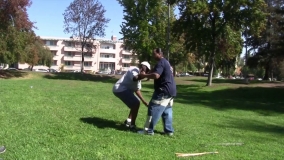 Indio Explains The Importance Of Sensitivity And Awareness For Creating Techniques And Counters
Indio Explains The Importance Of Sensitivity And Awareness For Creating Techniques And Counters5 minutes and 39 seconds
Indio explains the importance of developing heightened levels of sensitivity and awareness for creating and inventing various techniques and counters. He also talks about the importance of sensitivity for allowing us to detect and evade dangerous encounters and attacks.
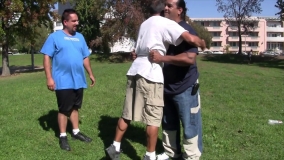 Indio Demonstrates Various Counters For Takedown Defense Against A Grappler
Indio Demonstrates Various Counters For Takedown Defense Against A Grappler11 minutes and 7 seconds
Indio demonstrates a variety of ideas of how to defend against a grappler when the grappler shoots in high, medium, or low. He demonstrates various flesh tearing techniques along with devastating knee strikes and more.
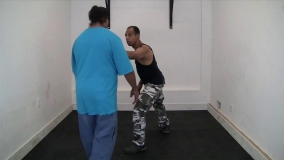 Dave And Indio Demonstrate A Great Partner Drill For Learning To Hit 360 Degrees Around Your Body
Dave And Indio Demonstrate A Great Partner Drill For Learning To Hit 360 Degrees Around Your Body7 minutes and 18 seconds
Dave and Indio demonstrate an effective partner and solo drill for learning to hit with power in 360 degrees. This is a critical skill to develop for defending against multiple attackers. This drill can be practiced by yourself at home or with a partner or with multiple training partners.
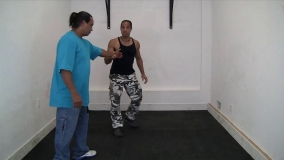 Dave And Indio Demonstrate A Partner Drill For Projecting Attackers 360 Degrees Around You
Dave And Indio Demonstrate A Partner Drill For Projecting Attackers 360 Degrees Around You8 minutes and 14 seconds
Dave and Indio demonstrate a great partner drill for learning how to manipulate and project an attacker 360 degrees around your body. This is very important for multiple attackers. You need to be able to effortlessly use the first attacker’s body as a projectile weapon or shield against the attacker’s friends.
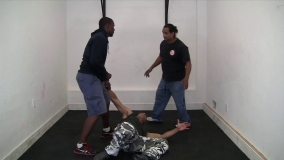 Randori Drill Using Attacker #1 As A Shield Or Projectile Weapon Against Attacker #2
Randori Drill Using Attacker #1 As A Shield Or Projectile Weapon Against Attacker #214 minutes and 7 seconds
Indio and Dave work with Phil to help him learn how to utilize the first attacker as a shield or projectile weapon against the second attacker. Indio demonstrates this and then Phil gives the exercise a try. This is a very important drill to practice during times that you have multiple training partners. If you only have one training partner then you can play with the clock face exercise that we saw in an earlier module.
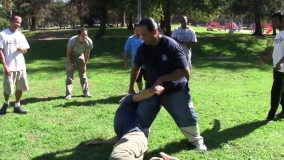 “Randori” Or Free Sparring Demonstration
“Randori” Or Free Sparring Demonstration1 minutes and 38 seconds
Indio demonstrates “randori” or free sparring against multiple attackers. He shows how you can learn to develop and invent techniques spur of the moment for whatever threat comes your way. There are no choreographed attacks or choreographed, regurgitated responses. Everyone is moving slowly so no one gets hurt. Additionally, the slow training allows your brain to learn how to begin creating and also empowers your sensitivity to perceive subtle nuances that would normally evade your senses. As your skill levels grows and if you’re training with a partner who is of a similar skill level you are free to increase the pace provided you are both training at a speed in which you have enough control not to injure one another.

